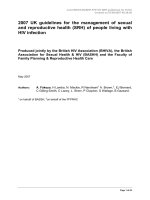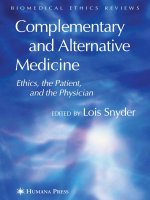Yoga for your eyes ( pdf)
Bạn đang xem bản rút gọn của tài liệu. Xem và tải ngay bản đầy đủ của tài liệu tại đây (871.23 KB, 74 trang )
STUDY GUIDE
YOGA
For Your
EYES
Natural Vision
Improvement
Exercises
Meir Schneider
Sounds True, Inc., Boulder, CO 80306
© © 1999 Meir Schneider. All rights reserved.
No part of this study guide may be used or reproduced
in any manner without written permission from the
author and publisher. Published 1999
Printed in the United States of America
Substantial portions of this study guide are excerpted
from The Handbook of Self-Healing, by Meir Schneider
and Maureen Larkin with Dror Schneider, © 1994 by
The Self-Healing Research Foundation. Reprinted by
permission of Penguin Arkana.
Meir Schneider.
Yoga for Your Eyes.
ISBN 1-56455-662-X
Also by Meir Schneider:
Books
Self-Healing: My Life and Vision (Penguin Arkana, 1989)
The Handbook of Self-Healing (with Maureen Larkin
and Dror Schneider) (Penguin Arkana, 1994).
Sounds True Audiotapes
Meir Schneider’s Miracle Eyesight Method (two
cassettes, 1996)
For more information on the work of Meir Schneider,
contact: The School for Self-Healing, 2218 48rh Ave.,
San Francisco, CA, 94116 / Phone: (415) 665-9574 /
Fax (415) 665-1318 / E-mail:
Web site: www.self-healing.org
For a free catalog of audio and video tapes, please
contact: Sounds True, P.O. Box 8010, Boulder, CO,
80306-8010 / Phone (800) 333-9185
Web site: www.soundstrue.com
HOW TO USE THIS STUDY GUIDE
This study guide and the Yoga for Your Eyes video each
stand alone. The study guide is designed to give you
an in-depth understanding of your own vision
problems and an overview of the techniques you can
use to improve them. The video is a visual aid that
can guide you through the exercises in the correct
way. Ideally, you should read the study guide first.
Then, when you watch the video, you will have a
good foundation for following along with the
exercises you choose to do.
TABLE OF CONTENTS
BETTER EYESIGHT, HEALTHIER EYES
What Is Vision?
Causes of Poor Vision
DR. WILLIAM H. BATES OPHTHALMOLOGIC VISIONARY
THE BODYMIND CONNECTION
1
2
3
6
8
Your Eyes and Your Brain
10
Your Eyes and Your Emotions
THE FUNDAMENTALS OF YOGA
FOR YOUR EYES
11
Union with Your Eyes
14
The Basic Principles of Yoga for Your Eyes
15
12
Relaxation
16
Adjusting to Light
17
Balancing Your Eyes
CAUTIONS: PLEASE READ THIS BEFORE
BEGINNING YOUR EXERCISES
Relaxing Your Body
Self-Massage
Guidelines
Facial Massage
Relaxing Your Neck, Head, and Shoulders
EYE EXERCISES
18
19
21
22
22
23
25
28
Balancing the Muscles around Your Eyes
28
Palming
29
Emotional Effects of Palming
32
How Often Should I Palm?
33
Blinking
33
Testing Your Vision
35
Stimulating Peripheral Vision
36
The Long Swing
Shifting
39
40
How Often Should I Shift?
43
Shifting Exercises
43
Shifting with an Eye Chart
44
Reading
45
Protecting Your Eyes when You Read 46
Reading and Shifting
47
Reading Upside Down
48
Shifting with Varying Print Sizes
48
Shifting/Waving with Varying Print Sizes 50
Shifting/Waving with an Eye Chart
50
Reading and Peripheral Vision
51
Creating Flexibility between Near and
Distant Vision
Sunning
51
52
How Long Should I Sun?
54
Sunning Variation
55
Skying
55
MAKING TIME FOR YOUR EYES
56
CONCLUSION
57
APPENDIX A: A Three-Day Guided
Palming Meditation
58
APPENDIX B: Print of Varying Sizes
61
GLOSSARY
62
ADDITIONAL RESOURCES
65
BETTER EYESIGHT,
HEALTHIER EYES
While most of us know that we can improve our
health and live longer by eating better, getting
regular exercise, reducing stress, and learning
relaxation, when it comes to our eyes we have a kind
of learned helplessness. Very few of us believe there
is anything we can do to make our eyes healthier and
improve our eyesight. The fact is, however, that the
things we do to improve our bodily health are also
good for our eyes.
The eye is not simply a mechanical tool. Like
every other part of your body, it is profoundly
affected by your state of mind. For no good reason,
the popular belief today is that vision can only
deteriorate and cannot improve. Statistics show
that most people who see poorly never see well afterwards; their vision just gets worse and worse. But
these statistics might look very different if we were
taught how to take care of our eyes - and, even more
importantly, if we understood that we have the
power to improve our eyesight.
MEIR SCHNEIDER
WHAT IS VISION?
Vision is the sum total of sensation, perception, and
conception. Mechanically speaking, your retina has
about 126 million light-sensing cells that produce
some billion images every single minute. The brain
cannot possibly assimilate all those images to create a
picture, so it selects — basically determining how
much of a picture you will and will not see. How
clear or how poor your vision will be is largely a
function of your brain.
Western medicine tends to ignore the complex
interactions between eye and brain. Medical training
puts greater emphasis on treating the symptoms. If
you have cataracts, doctors will remove the lens. If you
have high pressure in the eye, they will alleviate it. If
you see poorly, they will give you glasses. They do not
tend to go deeply into the causes of these conditions.
Yet nearsightedness, for example, is clearly the
result of mental stress and the fact that your brain
conceives of the world as a fuzzy place. Most children
who become nearsighted do so at about third grade,
when the initial excitement of learning has subsided
and they begin to glimpse the unchanging pattern of
school years ahead of them. Those who do not get
glasses in third grade generally get them in college,
when the future is not clear and seemingly endless
studies lie ahead.
Farsightedness, on the other hand, tends to
develop in our forties and fifties, when most divorces
happen and when people ask themselves, “Could I
live my life differently?” There is no question in my
mind, after nearly thirty years of working with all
kinds of vision problems, that your eyesight is truly a
part of your mental state. Helping your eyesight is
not simply an issue of getting rid of your glasses, but
of dealing with your total being: your mental,
emotional, and physical state in its entirety.
-2-
YOGA FOR YOUR EYES
Causes of Poor Vision
Vision problems usually manifest as lack of clarity in
either near or distant vision. The physical act of
seeing things close up is different from that of seeing
things in the distance. Consider, for example, how a
camera works. When light rays from the object you
are photographing reach the cameras lens, they need
to converge so that they are focused on the film
behind the lens. To focus, you change the distance
between the lens and the film until it is just right —
otherwise the object will not focus exactly on the film
and the photo will be a blur.
In the same way, your eye needs to converge light
rays from the object you are looking at and focus
them behind the lens. Instead of film, you have a
retina: a network of nerve cells that translates the
light rays into neural information. These data are
sent through the optic nerve to the brain. Where a
camera changes the distance between lens and film,
the eye changes the shape of the lens instead.
When the ciliary muscles that hold the lens in
place are relaxed, the lens is relatively flat and allows
for distant vision. When the object you are looking at
is closer than twenty feet away, those muscles
contract, and the lens assumes a more spherical shape.
This process is called accommodation (see fig. a).
Another factor thought to determine how a person
sees is the shape of the eyeball. Irregularly shaped
eyeballs are considered the cause of the two most
common vision problems: myopia and hyperopia.
Myopia (nearsightedness) means the inability to see
distant objects clearly, caused by an eyeball that is too
long from front to back. This shape makes it impossible for the lens to focus the light rays from distant
objects onto the retina (see fig. b), though it can
focus the rays from close objects. Hyperopia, or
-3-
MEIR SCHNEIDER
Fig. a: How an eye works: when the object is close,
the lens changes shape, becoming more spherical.
hypermetropia (farsightedness), refers to the inability
to see close objects clearly. Here, the eyeball is too
short from front to back. Light rays from a distance
focus correctly, but the lens is unable to bring the
rays together before they reach the retina. If they
were capable of passing through it, the rays would
probably focus behind the retina (see fig. c).
These descriptions explain the mechanical
conditions underlying poor vision. But what causes
these physical changes to occur? In one word, the
answer is stress. The eyes are as susceptible to stress as
is any other part of the body, and are subjected to at
least as much of it.
Two components of visual stress - prolonged,
unrelieved near-focusing and tasks with high-level
-4-
YOGA FOR YOUR EYES
Fig b: Myopia is caused by an eyeball that is too long
from front to back. The lens can not focus distant objects
onto the retina, creating a blurry image.
Fig. c: Flyperopia is caused by an eyeball that is too short
from front to back. The lens focuses close objects beyond
the retina, creating a blurry image.
cognitive demand — often coincide in school and office
work. The advent of computers has compounded the
problem, creating a visual/postural repetitive strain
condition called computer vision syndrome (CVS).
Symptoms include eyestrain, general fatigue, neck
and shoulder pain, dry eyes, and difficulties in
focusing. The computer screen is itself a visual stressor.
Since the eye can never determine the focal length of
computer pixels, it is plunged into a visual limbo in
which the ciliary muscle continually quivers with
unavailing effort. The visual stress of CVS tends to
bring on myopia or make it worse.
-5-
MEIR SCHNEIDER
Many of our actions and reactions — as well as
much of our memory — are guided by mental pictures,
including conscious and subconscious images of
events that shaped our emotional makeup. Our eyes
are stressed even when we are perceiving these only
“in the mind’s eye.” All of these events take place in
the brain, of which the eye is an integral part.
Because of all this, and also because we use them for
just about everything we do, our eyes respond
strongly to our thoughts and emotions. Because they
work so constantly and so hard, they are also
extremely sensitive to physical pain and fatigue.
Poor vision arises from a complex interplay in the
bodymind. This is why, when we begin working to
improve our eyes, we need to approach this work
from every possible angle. It is also why, in the
process of doing so, we discover things about ourselves that we may never have suspected.
DR. WILLIAM H. BATES OPHTHALMOLOGIC VISIONARY
You may have heard of the Bates Method: a series of
exercises designed to strengthen eyesight without the
use of glasses. Its creator is Dr. William H. Bates,
who was born in 1860 and graduated from Cornell
University’s College of Physicians and Surgeons at
the age of 35. Three years later, he was serving his
internship at Columbia Hospital in New York as an
ear, nose, throat, and eye doctor (in those days, these
specialties were combined). Dr. Bates was working as
a teaching assistant, but was dismissed after repeatedly encouraging fellow doctors to go without the
glasses prescribed for them by the chief ophthalmologist at the hospital eye clinic.
- 6-
YOGA FOR YOUR EYES
Dr. Bates used an instrument called the
retinoscope, with which he could observe minute
changes in the surface curvature of the eyes, and
thereby determine the nature and degree of a patient’s
vision problems. Over many years, he observed the
eyes of hundreds of patients in every kind of activity,
emotional state, and physical condition. He noted
how their eyes changed when they were doing work
they enjoyed, and when they were doing work they
disliked; when they were fatigued, anxious, or confused; when they were focused, excited, stimulated,
or relaxed.
Among the discoveries Dr. Bates made was how
visual clarity changes — in the same person — from
good to bad and back again, depending on that
person’s physical and emotional state. He concluded
that vision is not a static condition, but one that
changes constantly. In your own experience, you’ve
probably noticed that your vision is better at some
times than at others. Dr. Bates was the first
ophthalmologist to make a scientific study of this
phenomenon. His research shows how vision defects
can be created and/or worsened by the stress of everyday situations. He also proved that these problems can
be corrected by conscious and correct visual behavior.
Dr. Bates died in 1931, having spent his life
researching and developing a method to relieve the
unnecessary suffering of people afflicted with eye
disorders. His compassion and concern for his patients
was legendary. Upon seeing an infant fitted with tiny
glasses, Dr. Bates remarked, “It’s enough to make the
angels weep.”
The exercises on Yoga for Your Eyes are based on the
Bates Method, with refinements and additions
developed during my nearly three decades of reversing
my own blindness and helping others work with their
visual problems. These methods have been proven
-7-
MEIR SCHNEIDER
effective in relieving all refractive conditions (any
structural problem affecting the trajectory of light
within the eye), correcting squints and lazy eyes, and
similar problems. They do not necessarily address eye
diseases; but they do help you nurture healthier eyes
that are more resistant to disease and better able to
heal themselves from any reversible condition.
THE BODYMIND CONNECTION
The British writer Aldous Huxley was a successful student and enthusiastic admirer of Dr. Bates’ method.
After using his exercises to recover from a condition of
near-blindness, Huxley wrote a book called The Art of
Seeing, in which he described seeing as a three-step
process involving the eyes, the brain, and the mind.
He explained that seeing consists of:
Sensing - the light-sensitive cells of the eyes
receive information about their environment via light
rays — approximately one billion bits of visual data
during any given second.
Selecting — the mind cannot deal with all of the
visual data being conveyed to the eyes, so it directs
the eyes to pay attention only to certain data.
Perceiving - the selected visual data are recognized
and interpreted by the mind.
Visual improvement requires that we recognize
vision as a complex interaction between the eyes and
the mind. We also need to learn how to make the
mind work for us, rather than against us. One of the
biggest obstacles we need to overcome is the belief
that the eyes can never improve. This belief can keep
us from recognizing or accepting improvement
when it does occur, or convince us that in certain
situations we simply will not be able to see and
therefore should not try.
-8-
YOGA FOR YOUR EYES
Sometimes our vision may worsen when we
expect it to, in situations where we feel our eyes are
being challenged. Dr. Bates described a situation in
which he had two of his patients, one with excellent
vision and the other with poor vision, look at a blank
wall. During this experiment, he monitored changes
in the surface curvature of their eyes with his
retinoscope. As long as both patients looked at the
blank wall, their eyes remained the same. As soon as
he placed an eye chart on the wall, the eyes of the
person with poor vision changed radically, with all
the surrounding muscles contracting sharply. The
eyes of the person with good vision showed only a
slight, barely noticeable change. The first one had
immediately and unconsciously brought his habits of
straining into his effort to see the chart.
To improve vision, you need to change the way you
think about seeing, as well as the way you go about
seeing. This is a large undertaking. Visual habits and
patterns of use are among the hardest to change; we are
more attached to the way we see than to almost
anything else we do. Perhaps this is because our
memory consists so much of visual information. Once
we have seen something in a certain way, we remember it that way and continue to see it as we remember
it. Our dependence on sight is enormous, especially in
people who see well. When these people lose their
good vision, it can be really traumatic, changing their
entire self-concept. In reality, such people have great
resources to help them restore their vision: namely,
their memories of clear, sharp visual images.
Memory and imagination are the mind’s most
valuable tools for improving vision, and you will find
them used in many of the exercises on Yoga for Your
Eyes. Anything we have ever seen clearly can be used
to stimulate clearer vision. We all know that it is
easier to see things that are known and familiar. For
-9-
MEIR SCHNEIDER
example, an unfamiliar word, though it is made up of
the same letters, will initially be harder to decipher
than a familiar one. We use visualization exercises to
take advantage of the mind’s tendency to associate
clear vision with that which is known and familiar.
We also use visualization or imagination to create
optimal conditions. Imagining total blackness, for
example, can cause the optic nerve to react as though
it were, in fact, seeing total blackness — that is, to stop
working and rest.
The mind, like any other powerful force of nature,
can either help or harm. It can keep us from believing
that our vision can improve, or it can supply us with
everything we need to improve it.
YOUR EYES AND YOUR BRAIN
The most important visual organ is the brain. The
eyes and the brain even share the same kinds of
tissue. Our sensitive eyes respond to the minutest
chemical changes in the brain — including those
caused by emotional states and mental events.
Theories that blame eye structure as the origin of our
visual problems are very limited, in that they do not
recognize the profound bodymind dynamics that
cause the structural changes to begin with.
Conventional ophthalmology holds that structure
creates function; this is why poor vision is typically
treated with instruments or surgeries designed to
change the structure of the eye. But the truth is that
all vision begins with thought. Your thoughts
dictate how your eyes function, and the way your
eyes function changes their structure. If you learn to
function differently with your mind, you may also
change the structure of your eye.
The extent of your brain’s control over visual
function is evident in the way it makes sense of
- 10 -
YOGA FOR YOUR EYES
impressions that your eyes alone cannot interpret.
For example: physics teaches that, although you
perceive objects as right side up, your lens and retina
are seeing them upside down. Your eyes have no
mechanical function that translates the upside-down
images into the perspective you normally see. It is
your brain that needs to put everything right side up,
to create order in the world. A startling experiment
illuminates this point quite vividly.
A group of pilots was given glasses that made
everything appear upside down. Within a couple of
days, their brains righted their vision and they saw
everything right side up again, even through their
glasses. Two weeks later, the glasses were taken away.
Everything turned upside down. Some of the pilots
actually suffered nervous breakdowns; but with
time, they all saw things right side up again without
the glasses.
The vast extent to which vision is a mental state is
the territory Western medicine does not address.
Symptomatic solutions — surgery, glasses, and so on do help you see better in the short term; but ultimately,
they make your eyes weaker. Meanwhile, these remedies perpetuate the myth of helplessness that keeps
you from strengthening your vision through self-care
— an approach that has not only been effective for
many thousands of people, but is far preferable in
terms of both visual function and self-empowerment.
YOUR EYES AND YOUR EMOTIONS
Vision is also very much an emotional state. Almost
every client I have worked with has experienced
strong emotions — and sometimes powerful emotional
insights — while working to improve their vision.
Conversely, strong negative emotions nearly always
worsen vision temporarily. This is true even for people
-11-
MEIR SCHNEIDER
with good eyesight. If the emotional stress continues,
damage to the eyes can become permanent.
Much visual deterioration is due to an unwillingness to observe the world closely. Our eyes lose their
ability to “shift” from one detail to another, resulting
in a frozen stare that stresses our eyes tremendously.
Yet when we are under emotional stress, the last thing
we want to do is look at the details of our situation.
It is less painful, at times like this, to partially “blind”
ourselves to the reality of our experience. Our vision
becomes fuzzy in an attempt to protect us emotionally.
Unfortunately, our typical reaction to this situation is
to force our eyes to perform as usual. We acquire
glasses, or get a stronger prescription.
If you strained your back by using it to lift heavy
objects, you would not think of just getting a back
brace and continuing to use your spine in the same
way. Yet this is precisely how we treat our eyes. It
would be much better for your long-term visual
health if you simply acknowledged your need to see
less clearly for a while. This is a time to rest and support
your eyes, your body, and your mind. In a world
dedicated to functionality, this might be difficult to
do - yet to ignore physical and emotional distress
signals is to risk permanent damage to your ability to
function. If you nurture your eyesight through the
hard times, it will return to its previous capacity
when things start (literally) looking up again.
THE FUNDAMENTALS OF
YOGA FOR YOUR EYES
Our primitive ancestors used all their senses — including
their vision - fully. They looked into the distance;
they noticed the slightest movement at the far
periphery of their vision. Their eyes shifted constantly
- 12 -
YOGA FOR YOUR EYES
from detail to detail, from close up to far away. They
could find their way both in the dark and in the full
light of day.
Sadly, our reality today is not nearly so fluid. Life
hardens our bodies. When we work hard, we tense
our posture and contract. When we read or work at
the computer, the rest of the room is of no interest to
us. We spend most of our days staring at work just a
few inches from our noses. Daylight blinds us when
we step outdoors after working inside all day; we find
ourselves straining to see in the dark.
These bad visual habits lead to a “frozen” look: a
gaze that basically discounts much of the visual field.
We do not use the larger portion of the visual capacity and acuity naturally available to us - and in time,
the brain reinforces this behavior and fixates the eye
around it. In this way, it creates a predictable reality
in which we expect to see only certain things and
only in certain ways. It imposes its visual memory to
recreate our visual experiences in the moment.
On Yoga for Your Eyes, you will learn how to
develop what I call “soft eyes”: eyes that are truly open
to whatever there is to see. The concept of soft eyes
was developed by martial arts practitioners to describe
the kind of vision necessary in order to be aware of
three opponents coming at you from different
directions. With a frozen gaze, you would only be able
to focus on one at a time, which would lead very
quickly to your defeat.
By contrast, soft eyes have great presence. They
take in the whole room, the whole landscape, without
straining for any particular visual impression.
Looking with soft eyes is similar to taking a walk for
the pure pleasure of moving your body, without
scheming over the calories you are burning or the
muscles you are toning. Soft eyes absorb the world,
rather than trying to capture it; your eyes rest while
- 13 -
MEIR SCHNEIDER
you look, rather than striving. With soft eyes, the
process of looking is as important as the content of
what is seen. Obviously, this is a much more relaxed
approach to living than the one most of us are used to.
UNION WITH YOUR EYES
“Yoga” is a Sanskrit word that literally means “yoke”:
the device that harnesses an ox to a wagon. It was
originally used in Hindu tradition to describe the
harnessing of self with the divine. In contemporary
usage, we translate “yoga” as “union” — in other
words, an attitude of joining with our experience,
rather than trying to separate ourselves from it.
Often, we try to distance ourselves from our world by
numbing ourselves, pushing away our feelings, or
trying to freeze time so that we do not have to deal
with the possibility of distressing changes. “Yoga for
your eyes” means uniting with your eyes: being
present with them, exactly the way they are.
When we unite with our eyes, we set aside our
preconceptions and become curious about their true
experience. We begin to pay attention to them,
noticing when they are tired or irritated. As we would
with any good friend, we attend to their needs: resting
them when they have been working hard and gently
exercising them when they become weak or damaged.
All the exercises on Yoga for Your Eyes are based on
these principles. So are the following guidelines, with
which you should work whenever you exercise and
throughout the day. Practice these suggestions, and
you will find that your eyes are surprisingly responsive
to your nurturing attention. Never, under any circumstances, strain to see anything. It is impossible to
force better vision - in fact, trying to do so will
reverse all the benefit you derive from these exercises.
- 14 -
YOGA FOR YOUR EYES
Instead, notice what you do see and use that information to enhance your exercises.
• Let your vision be what it is. If it is blurred, do not
try to make it clear. Simply work with what you
have and notice what mental, physical, and
emotional conditions contribute to changes in
your eyesight. (You do not have to change these
conditions, by the way; just being aware of them
will start a natural process of change.)
• Do not force yourself to do any exercise that feels
uncomfortable to you. Discuss any qualms you
may have with your ophthalmologist, and use
your own judgment and intuition to personalize
the program for your unique needs.
• Goals are a setup for disappointment and
frustration. Imposing a schedule on your visual
improvement is counterproductive. Discover your
own pace and respect it; this is truly the fastest
way to improve your eyesight.
• Remember that your eyes are not isolated from
the rest of your body. If your back hurts, or your
neck is tense, or you do not eat well, your eyes
will respond to these stresses by losing function.
Make Yoga for Your Eyes part of an overall program
for nurturing your body, mind, and spirit.
THE BASIC PRINCIPLES
OF YOGA FOR YOUR EYES
There are many ways you can work on your eyes.
Some techniques concentrate specifically on a
particular aspect of visual function; others on the
health of your eyes; and still others on your overall
well-being. Ideally, your daily workout will touch on
all these elements - but in order to understand the
- 15 -
MEIR SCHNEIDER
program more clearly, we can group all the exercises
into three basic categories:
• relaxation
• adjusting to varying intensities of light
• balancing your eyes
Relaxation
The eye is one of the hardest-working organs in the
body, and people who use their eyes a lot become
fatigued more rapidly than others. This partially
explains why a typist can be as exhausted as a lumberjack at the end of a workday. We use our eyes
every minute we are awake — typically, about seventeen hours daily.
Imagine how your muscles would feel if you used
them nonstop, every waking moment. If you work,
as many of us do, at a job that requires constant and
strenuous use of your eyes, consider how your body
would feel if you forced it to walk all day, every day,
under the weight of a heavy burden. This is the kind
of pressure we put on our eyes.
You might feel that you relax your eyes for many
hours each day, while you sleep. The fact is that
during much of our sleep time, our eyes are not
resting enough. During dreams, the optic nerve is
stimulated and the eyes are in motion under our
closed eyelids. It has been clearly established that all
humans spend several hours a night in this state. In
addition, many people do not relax during sleep, but
maintain their tensions — particularly in the upper
body and face.
Ideally, you should be able to improve your vision
through both use and rest. Everything you do with
your eyes should be good for them. One of the most
important things you can do for them is simply to
- 16 -
YOGA FOR YOUR EYES
counteract the abuse to which they are typically
subjected. The most effective way to accomplish this
is through relaxation.
Your eyes are an integral part of your body. It is
unrealistic to think you can relax them when the rest of
your body is tense. This is why Yoga for Your Eyes begins
with self-massage and other relaxation techniques.
Adjusting to Light
Light is the vehicle that brings all visual information
to your eyes. People who spend much of their time
working outdoors under bright, natural light tend to
have better eyesight than those of us who live mostly
indoors, because their eyes are accustomed to - and
comfortable with - strong light. They can accept and
use the light fully. The more time we spend under
dim, inadequate, artificial lighting, the less our eyes
are equipped to deal with light. Normal sunlight can
feel like a spotlight shone into your face.
This is partly because spending most of your time
indoors forces your pupils to chronically dilate,
opening as wide as possible in order to take in all
available light. The muscles around your eyes will
tend to tighten, squinting to shut out the painful
glare. Many people are currently walking around
with sunglasses or with a perpetual, unconscious
squint shielding their eyes from “excess” light.
To some extent, squinting works temporarily. Its
long-term effects, however, are very detrimental to
vision. It causes the muscles around the eyes to
constantly contract, which changes the shape of the
eyeball. It also cuts out a large part of the peripheral
visual field, forcing the eyes to stare fixedly, with
effort, at a very small area. Sunglasses are about as
helpful, in this situation, as a wheelchair to a person
with weak leg muscles: they provide temporary relief,
- 17 -









